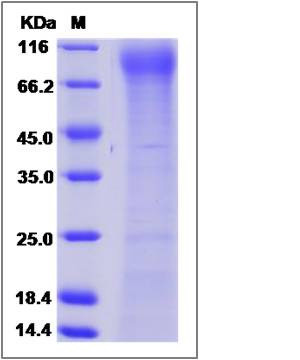Mouse FLT-3 / CD135 / FLK-2 Protein (His Tag)
B230315G04,CD135,Flk-2,Flk2,Flt-3,Ly72,wmfl
- 100ug (NPP3324) Please inquiry
| Catalog Number | P51119-M08H |
|---|---|
| Organism Species | Mouse |
| Host | Human Cells |
| Synonyms | B230315G04,CD135,Flk-2,Flk2,Flt-3,Ly72,wmfl |
| Molecular Weight | The recombinant mouse FLT3 comprises 528 amino acids and has a predicted molecular mass of 59.5 kDa. |
| predicted N | Asn 28 |
| SDS-PAGE |  |
| Purity | > 75 % as determined by SDS-PAGE |
| Protein Construction | A DNA sequence encoding the mouse FLT3 (EDL05833.1) (Met1-Ser544) was expressed with a C-terminal polyhistidine tag. |
| Bio-activity | |
| Research Area | Signaling |Signal Transduction |Receptor Tyrosine Kinases (RTKs) |
| Formulation | Lyophilized from sterile PBS, pH 7.4. 1. Normally 5 % - 8 % trehalose and mannitol are added as protectants before lyophilization. Specific concentrations are included in the hardcopy of COA. |
| Background | The cluster of differentiation (CD) system is commonly used as cell markers in immunophynotyping. Different kinds of cells in the immune system can be identified through the surface CD molecules which associating with the immune function of the cell. There are more than 320 CD unique clusters and subclusters have been identified. Some of the CD molecules serve as receptors or ligands important to the cell through initiating a signal cascade which then alter the behavior of the cell. Some CD proteins do not take part in cell signal process but have other functions such as cell adhesion. CD135, also known as FLT-3, FLK-2, is a member of the CD system. CD135 is an important cell surface marker recognized by specific sets of antibodies to identify the types of hematopoietic (blood) progenitors in the bone marrow and it function to differentiate hematopoietic stem cells, which are CD135 negative, from multipotent progenitors, which are CD135 positive. CD135 is a receptor tyrosine kinase typeⅢ for the cytokine Flt3 ligand and activat signaling through second messengers by binding to Flt3. Signaling through CD135 is important for lymphocyte development. The encoding gene CD135 is a proto-oncogene to which mutations happened will lead to cancer such as leukemia. |
| Reference |
